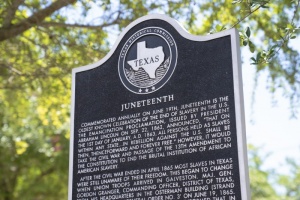Going to Galveston: the birthplace of Juneteenth

January 1, 1863, is a date etched in U.S. history. It’s the day President Abraham Lincoln issued the Emancipation Proclamation declaring, “all persons held as slaves” shall be free.
But it would be nearly two and a half years until that proclamation was realized, and the last group of enslaved people in the country were set free. On June 19, 1865, Major General Gordon, along with thousands of Union soldiers arrived in Galveston Bay to free 250,000 Black people, still under slavery in the state of Texas – the final Confederate stronghold to fall. *
When the army arrived, it issued General Order No 3. stating:
“The people of Texas are informed that in accordance with a proclamation from the Executive of the United States, all slaves are free. This involves an absolute equality of personal rights and rights of property between former masters and slaves, and the connection heretofore existing between them becomes that between employer and hired labor.”
Absolute Equality. Those words are now etched on a stunning mural in downtown Galveston that was unveiled last year. It tells a visual story of the journey of Black Americans from slavery to freedom.
ADVERTISEMENT
In 1980, Texas became the first state to make Juneteenth an official holiday. Today, it is a federal holiday that’s celebrated in more than 200 cities throughout the country. Still, nowhere is it more significant than in Galveston.
In the years and decades that followed 1865, those once enslaved, and their descendants began celebrating June 19 as a day of freedom – Emancipation Day. They would make the pilgrimage to Galveston and pass stories down from generation to generation. This oral history helped document the story of Juneteenth long before history books took notice.
“To be immersed in the story of Juneteenth, to really feel its importance – you must come to Galveston,” says Sam Collins, president, and co-chair of the Juneteenth Legacy Project – a nonprofit group under the wing of the Nia Cultural Center.
“I make an analogy to swimming. When you are learning to swim, you don’t just read books and watch videos, you have to actually get in the water, “says Collins. “That’s what coming to Galveston for Juneteenth is like – it’s getting in the water.”
Installed in 2014 by the Texas Historical Commission, the Juneteenth Marker is on stop one of the city’s “Freedom Walk,” highlighting five historic sites connected to Juneteenth. (Source: Visit Galveston)
“That Galveston is the actual birthplace of Juneteenth is a point of pride for our community. For years, we have endeavored to honor and celebrate this important milestone in the history of Texas and the nation,” says Michael Woody, chief tourism officer at Visit Galveston. “The fact that it has recently become a national holiday brings more attention to the significant event and Galveston. We hope this attention draws more people to the island to experience historical sites related to Juneteenth, in addition to our other attractions.”
Collins highlights the city’s Freedom Walk, starting with Pier 21 and the Middle Passage at the Port of Galveston, where Granger and his soldiers landed.
“The Juneteenth story is important to the entire country, and the goal of the Juneteenth Legacy project is to tell a complete narrative of American history,” says Collins. “When Granger arrived in 1865 with his Union troops – many of them were colored. They went from Galveston to the rest of Texas. They were heroes. If you want to really learn the Juneteenth story, you have to come here and walk in the footsteps of those soldiers who brought the message of freedom.”
In addition to freedom walk tours, there are several other events and educational opportunities for visitors. There are also, of course, celebrations – a festival, a parade, an art exhibit, and much more.
“The Juneteenth Freedom Project art exhibit, held at the Nia Cultural Center, is free to all visitors,” says Collins. “There is also a Juneteenth Jubilee on June 20, in front of our Absolute Equality mural. And for the first year, the group plans to auction some of the art to benefit the Nia Cultural Center.”
“We’re going to be auctioning art in the same area they once auctioned people,” says Collins. “It will be a powerful moment because when the enslaved people came here, they brought with them their art, their history, their culture – they weren’t property to be owned.”
Collins says he wants Americans – especially those who are descendants of slavery – to feel included and proud of the accomplishments and legacy of their ancestors.
“We have to repair and expand the narrative of who contributed to this great country,” he says. “Celebrating Juneteenth is a way to tell a more complete story of America and its march towards a more perfect union.”

